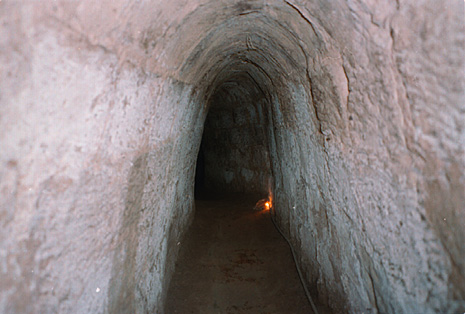An excellent collection of ideas, on how to shut down these tunnel systems on the borders of Gaza. I think a combination of several of these ideas are the way to go. Who knows, there might be some contracting opportunities with this one for some construction company. It would either be an Egyptian or Israeli company to work on this stuff, but you never know who they might contract for this stuff. I posted some stuff regarding the SBInet Boeing project along the US border, and they experiment and use a lot of the same stuff to detect tunnels.
My favorites are the combination of UAV/with sensors, and ground sensors, all tied into one center. It sounds expensive, but anything that could reduce the smuggling operations would equate to less rockets being manufactured and launched. The tunnel issue will be a big deal during the ceasefire–when it comes. –Matt
——————————————————————-
Holey War
How to close the Gaza tunnels.
By William Saletan
Posted Friday, Jan. 16, 2009, at 7:58 AM ET
In the skies over Gaza, Israel rules. Its planes, helicopters, and drones patrol and fire at will. On the ground, Israeli troops advance while Hamas lies in wait. But the ultimate battleground isn’t visible from the sky or on your television news. It’s underground.
Gaza is riddled with tunnels. Some are for smuggling; others are for transporting weapons; others are for hiding or ambushing Israeli troops. The crucial passageways—400 to 600, by recent estimates—run from Gaza to Egypt, circumventing the closed border. That’s how Hamas gets parts and material for the missiles it fires into Israel. Any deal to end the current fighting has to include “an effective blockading” of that border, “with supervision and follow-ups,” according to Israel’s prime minister. To stop the war—and to keep it stopped—you have to figure out how to stop the tunnels.
But how? Here are some of the options.
1. Buffer zone. Israel used to control a 300-meter strip between Gaza and Egypt. That wasn’t enough to stop Gazans from tunneling under it to Egypt. But what if the strip were thicker? Would that raise the cost of tunneling, or the probability of a collapse somewhere along the passage, enough to deter diggers? Israeli hawks want a buffer zone three kilometers thick, which would make tunnel excavation much more difficult, expensive, and time-consuming. Lately, the Israeli Defense Forces have dropped leaflets urging Gazans along the border to leave their homes—an attempt, some experts believe, to use the war to widen the buffer zone. But good luck getting Hamas, the Palestinian Authority, or European intermediaries to hand over three kilometers of south Gaza, much less remove the inconvenient residents from their homes.
2. Wall. Instead of thickening the old buffer zone, how about deepening it? Years ago, Israel tried a concrete-iron wall that extended 10 feet underground. A nice try, but fairly useless, since the tunnels went at least 20 feet underground. Then, just more than a year ago, two high-ranking officials from the U.S. Defense and State Departments went to Egypt with a proposal to build a new barrier, including “piles driven deep into the earth.” But even if you extend a wall far enough underground, tunnelers can dig through it.
3. Moat. Maybe, instead of burying a solid barrier that could be dug through, we should make the barrier hollow and fill it with water. That way, anyone trying to dig through would—well, let’s just say you wouldn’t want to be there when it happened. This was such an intriguing idea that Israel tried it several years ago, soliciting bids for a moat four kilometers long, 100 meters wide, and 80 feet deep. Estimated cost: $250 million. Israel scrapped the plan because the water would come from the sea and might contaminate Gaza’s groundwater. But the idea keeps coming back. Two years ago, Israel broached it again, and Egypt considered it. The U.S. officials who went to Egypt a year ago raised it again. Even the president of the Palestinian Authority has lobbied Egypt to do it.
